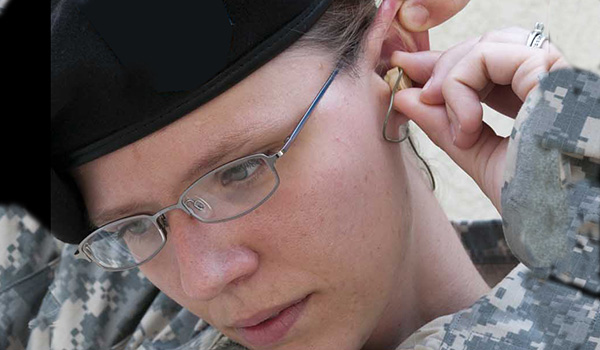
Ask the Flight Surgeon / By CPT Scott A. Cygan, MD: Q: I failed my annual audiometric screening and was told that I show early signs of noise-induced hearing loss. What can I do to protect my hearing from getting worse?

NIHL and Tinnitus
Noise-induced hearing loss (NIHL) is a permanent loss of hearing that results from exposure to hazardous noise without the use of proper hearing protection devices. NIHL can occur gradually over time or result from a single, unprotected exposure to high-intensity noise. NIHL usually occurs at higher frequencies and unfortunately, speech sounds that give meanings to words (consonants such as ch, th, sh, f and p) are also located within that same high frequency range. As hearing loss gradually progresses, communication deficits may initially go unnoticed, especially in quiet environments. As background noise is increased, as during flight, the percentage of effective communication can begin to decline and Houston, we have a “…sorry, what did you say?”
Unprotected exposure to high-intensity noise can also cause a temporary or permanently perceived ringing, buzzing or hissing sound in the ear called tinnitus. Tinnitus is a symptom of inner ear damage and when temporary, may serve as a warning sign of impending permanent damage with continued noise exposure. Once tinnitus has become permanent though, no definitive “cure” exists and treatment relies on methods to distract the brain from focusing on the ringing to improve quality of life. Together, tinnitus and hearing loss represent the #1 and #2 VA-compensated disabilities. Many Soldiers consider these to be an unavoidable by-product of military service but, taking some simple steps can save you from spending your retirement pension on pallets of hearing aid batteries.
The Army Hearing Program
The Army addresses hearing conservation through the Army Hearing Program (AHP) which maximizes Soldier and Civilian hearing through four components: hearing readiness, clinical services, operational hearing services and hearing conservation. The AHP attempts to conserve survivability, lethality, mission effectiveness and quality of life. Hearing readiness is used to ensure Soldiers have adequate hearing to perform the duties of their military occupational specialty and are fitted with proper hearing protection devices for their mission. Most importantly, the hearing readiness component includes annual audiometry exams to identify early changes in hearing, provide counseling and correct any deficiencies in hearing protection. After hearing loss has been recognized, clinical hearing services are intended to determine a Soldier’s auditory fitness-for-duty (FFD) by comparing a Soldier’s hearing ability against a medical standard. Treatment plans can be initiated which include tinnitus management, hearing aid prescription, aural rehabilitation, custom-molded hearing protection devices, and closer monitoring to prevent further hearing losses. The operational hearing services component focuses on preventing or mitigating NIHL during military operations while facilitating the Soldier’s need to communicate effectively. The Army Hearing Program provides all the necessary services and expertise to protect your hearing, but is meaningless if you do not take active part in protecting your hearing.
So What Can I Do?
The two most important factors to prevent NIHL are decreasing the duration and intensity of exposure to hazardous noise. For most pilots and aircrew members, decreasing the duration of time exposed to hazardous noise is rarely negotiable when on duty. However, limiting the duration of noise exposure while off duty is a very viable option. For example, consider limiting the noise exposure during your recreational activities such as shooting firearms, riding your motorcycle, boating, and yard work.
If lifestyle changes to decrease the duration of exposure are not an option, consider ways to decrease the intensity of noise reaching the ear. In both rotary and fixed-wing aircraft, overall noise levels generally equal 100 or more decibels and exceed thresholds that require ear protection by the Occupational Safety and Health Administration (OSHA). Non-custom hearing devices, such as standard communication ear plugs (CEPs), foam inserts, and triple-flange earplugs, provide adequate attenuation of noise for most. However, individual ears may vary widely in size and shape and some may benefit from custom-molded earplugs which can provide a better seal within the external ear canal. In addition, improper placement of hearing protection devices can completely void any attenuation of hazardous noise. Always remember to wear your hearing protection every time you may be potentially exposed to hazardous noise which includes those off duty activities mentioned previously. If you have concerns, discuss your technique for insertion and review the available custom-molded options with your local flight surgeon or audiologist.
Stay safe!
Questions ?
If you have a question you would like addressed, email it to This email address is being protected from spambots. You need JavaScript enabled to view it.; we’ll try to address it in the future. See your unit flight surgeon for your personal health issues. The views and opinions offered are those of the author and researchers and should not be construed as an official Department of the Army position unless otherwise stated.
CPT (Dr.) Scott A. Cygan is a flight surgeon at the U.S. Army School of Aviation Medicine, Fort Rucker, AL.








